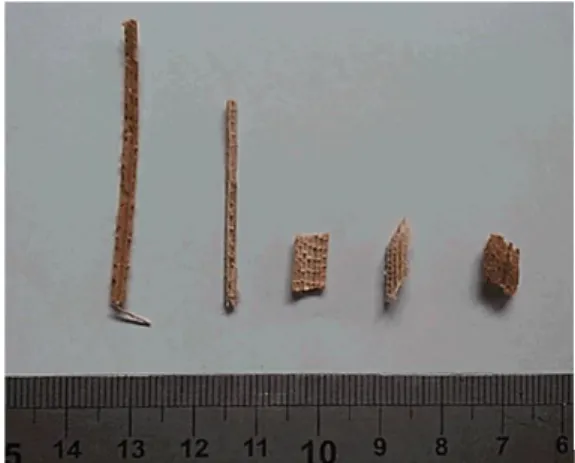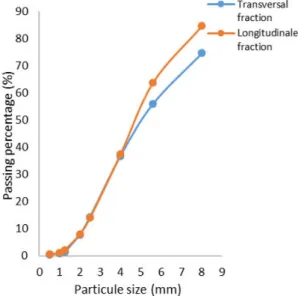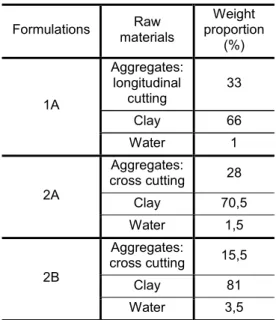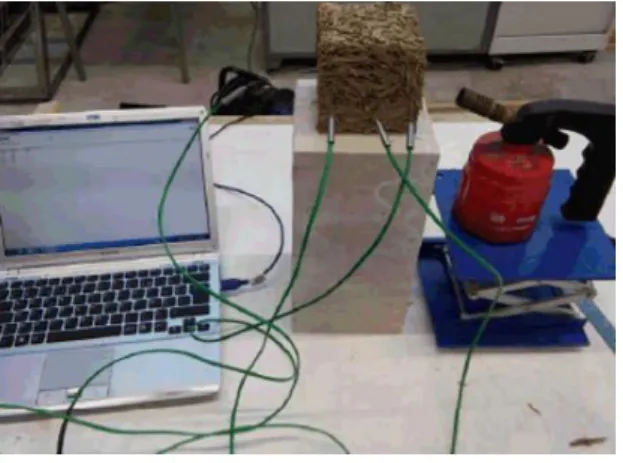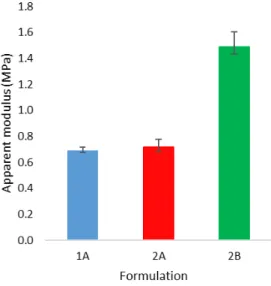EcoGRAFI
2nd International Conference on Bio-based Building Materials &
1st Conference on ECOlogical valorisation of GRAnular and FIbrous materials
June 21th - 23th 2017 Clermont-Ferrand, France
TYPHA BIO-BASED AGGREGATE MIXED WITH NATURAL CLAY TO FORM
COMPOSITES: THE COMPRESSIVE STRENGTH, THE HYGRIC PERFORMANCE
AND THE FIRE REACTION OF COMPOSITES ARE STUDIED
I. Niang1,2*, E. Samin3, C. Maalouf1, A. Gacoin1, P. Munoz4, J.F. Henry1, T.H. Mai1, S. Gaye2 1 GRESPI, SFR Condorcet FR CNRS 3417, University of Reims Champagne Ardenne, BP 1039,Reims, France
2 University of Thiès, LME, BP 120, Thiès, Sénégal
3Centre international de la construction en terre, CS 12636, Grenoble, France 4Centre de recherche et de développement Arago, Reims, France.
*Corresponding author; e-mail: ibrahim.niang@univ-reims.fr
Abstract
This work is part of the PNEEB / TYPHA project for the use of an invasive reed, the Typha
Australis, as a thermal insulation which aims to contribute to the energy efficiency of buildings in
Senegal. The Typha australis is widespread in aquatic environments and in humid regions, particularly in the Senegal River valley, whose proliferation has become an ecological threat. In this study, an agromaterial based on aggregates of Typha australis and clay is prepared: the influence of the morphology and of the amount of Typha on the behaviour of the material are investigated. Different combinations are tested. The first two have almost the same amount of binder but they differ in the production mode of the Typha aggregates: one type of the aggregates uses the longitudinal section of the plant while the other uses its cross-section. The third combination is an aggregate produced by cross-section with a higher amount of binder. Compression tests are carried out and the following properties are determined: apparent modulus and compressive strength. The Moisture Buffering Value is also characterized. The reaction to fire is estimated. The results show an impact of the amount of aggregates on the compressive strength. However, the influence of the morphology of the aggregates is negligible on this test. This material is an excellent moisture regulator regardless of the part of the Typha aggregate that is used. This material can be considered as a combustible but non-flammable material due to the presence of clay.
Keywords:
Typha Australis, clay, apparent modulus, compressive strength, Moisture buffering capacity, fire
reaction.
1 INTRODUCTION
The main challenge of the 21st century for humankind is to continue its activity on earth while preserving the environment. Industrial development has led to significant changes in human societies, including the acceleration of the economic and the social growth. However, one major aspect has been neglected: the environmental impact of these activities. The use of fossil energy, as the main source of energy [‘BP Statistical Review of World Energy’ 2015], has contributed to increasing the greenhouse gas emissions that cause global warming. Among the most important consequences, there are devastating meteorological phenomena (storms, floods, torrential rain), disorders due to the upheavals of ecosystems (species in the process of extinction, deforestation) and migratory flows induced by adverse economic circumstances. One of the solutions to mitigate these
consequences is to stem petroleum-based energy consumption. The building sector appears to be one of the most inclined sector which could generate energy savings. It accounts for about 44% and 54.7% of final energy consumption in France [ADEME 2005] and Senegal [‘Energy Information System of SENEGAL’ 2013.]. Therefore, building in an environmentally responsible manner is a top priority in this context of sustainable development.
To meet the challenge of ecoconstruction, there it is necessary to meet the requirements of HQE (Haute Qualité Environnementale) in France, of LEED (Leadership in Energy and Environmental Design) in the USA and of BREEAM (BRE Environmental Assessment Method) in the UK. Their objective is to assess the energy performance and environmental impact of buildings. Most of these requirements advocate the use of biosourced construction materials
such as wood, hemp and straw. These agro resources are of particular interest because of their low environmental impact (low embodied carbon energy), their technical performances [Gaye 2001], [Bal 2012], [Diaw 2016], [Cerezo 2005], [Samri 2008], [Glé 2013] (thermal and acoustic insulation, hygrothermal regulation). These characteristics are essentially due to the porosity of their internal structure [Glé et al. 2012], [Arnaud and Gourlay 2012] and their permanent renewal (renewable resources). The Typha Australis one of the most available plants in many humid zones across the world. It proliferates very quickly. In Senegal, its presence constitutes a real threat to the ecosystem and the socio-economic balance [PNUD 2013]. It has become a necessity to transform this threat into a resource opportunity by valorising it as fuel for domestic use and as building materials. This article will focus on the last one, which is developed with a binder whose choice is linked to its environmental criteria, i.e. clay: it is an entirely natural resource which requires very little processing and whose technical qualities are very well known [Guillaud ; Houben 2006], [Anger; Fontaine 2011], [Volhard 2016].
In this paper, the evolution of the compressive strength, the hydric performance and the fire behaviour of composites are studied. In a first step, the raw materials are presented and the physical characteristics are specified. Secondly, the experimental methods are detailed. In a last part, experimental results are shown and the impact of the amount and aggregates’ morphology of composites are discussed.
2 MATERIAL 2.1 Typha
The Typha australis is an herbaceous, monocotyledonous plant with a fibrous root system whose rhizomes up to 3.50 meters long. These rhizomes can produce oxygen, and ensure its survival for up to 6 days. It has a stem surrounded by flat leaves 1 to 2 cm in width, more or less triangular. It has a 15 to 20 cm long spadix which is brown at maturity and can contain between 20 000 And 700,000 seeds [Dieng 1999], [Theuerkorn 2002]. .
Figure 19 : Typha Australis
In our study, The Typha plants were harvested and transported from Senegal according to the standard norms [ASN 2014]. These norms specify all the operations to be carried out to ensure the harvesting, transport, drying and storage of Typha australis for the
production of thermal insulation materials for buildings. The Typha plants are cut manually using a sickle. The cutting height is 20 cm above the water level to keep it alive [Dieng 2002] and to ensure a continual harvest. Drying in the open air is carried out at the cutting site for seven to ten days depending on climatic conditions. The following step is the storage which is a very delicate operation and which must be perfectly carried out in order to avoid the development of mold. The
Typha plants are then packaged in bales and
transported by sea.
The aggregates of Typha are produced by cutting the plant, separated from the spadix (upper part containing the seeds) and the roots. To evaluate the impact of the morphology of the Typha granulate, we chose to make two types of cuttings of the plant: a longitudinal cut and a transversal cut.
The figure below illustrates how the Typha aggregates are produced (L: longitudinale cut; T: Transversal cut). The physical characteristics of the particles obtained are the following:
Figure 20 : Methods for cutting Typha plants
Aggregates resulting from the transversal cutting: this is a mode of splitting which permits to maintain the internal structure, characterized by a very high level of porosity. The outer surface of the fiber is rough. The bulk density of the aggregates resulting from this splitting is around 55 kg/m3 +/- 1.5.
Figure 21 :Morphology of the transverse fraction of Typha
The aggregates resulting from longitudinal cutting are similar to "chips": they have a very low intra-particle porous structure and a very smooth external wall. The bulk density is 60 kg / m3 +/- 1.2.
One notes that with the Typha which has been transversally cut the particles have a lower bulk density. This is due to the slightly higher porosity level of these aggregates.
Figure 22 : Morphology of the longitudinale fraction of Typha
Figure 5 shows that the transverse fraction is coarser than the longitudinal fraction. The latter is formed of thinner chips which don't contain visible macrospores.
Figure 23 : Grain size distribution curve of Typha aggregates
2.2 Clay
For the purpose of our work, we used a clay soil coming from Thicky town, in the region of Thiès (Senegal). Experimental tests have been carried out to characterize this soil. The purpose of these tests is to examine whether this soil is suitable for use as a binder in order to produce building materials. Among its fundamental properties, this soil presents particular specific characteristics, such as:
• Its granularity: the texture of the grains that make up the soil;
• Its plasticity: the ability of the earth and its way to react in contact with water.
Figure 6 [Riveros Olmos 2016] shows that the Thicky soil it is a clayish one containing almost 62% of very fine particles.
According to AFNOR standards [AFNOR 1993], the limits of Atterberg are tests which make it possible to define indicators qualifying the plasticity of a soil, and
more precisely to predict the behaviour of the soil according to the variations of water content.
Three geotechnical parameters are determined: • Liquidity limit [WL]: the water content of a soil at the point of transition between the liquid and plastic states; • Plasticity limit [WP]: the water content of a soil at the point of transition between the plastic and solid states; • The plasticity index [Ip] which is the difference between the limits of liquidity and plasticity. This parameter makes it possible to evaluate the range of water content in which the soil is in the plastic state.
Figure 24 : Grain size distribution curve of Thicky soil Tab 3 : Atterberg limits of Thicky soil
Liquidity limit [WL] Plasticity limit [WP] The plasticity index [Ip] 50,15% 19,19% 31,03
The results (tab 1) [Riveros Olmos 2016] show that the Thicky has a plasticity index between 15 and 40. According to the classification (tab 2), it is considered a very plastic soil.
Tab 4 :Classification of the degree of plasticity as a function of the plasticity index
Plasticity index Plasticity degree
0<IP <5 Non-plastic 5<IP <15 Moderately plastic 15<IP <40 Plastic
IP >40 Very plastic
We currently have no information on the chemical composition of the clay from Thicky town. We plan to request a chemical analysis by a laboratory.
2.3 Formulation of materials
The materials' formulas were implemented to estimate the influence of the type and the amount of Typha aggregates on the behaviour of this eco-material. Three formulations are prepared:
The first two formulations (1A and 2A) produced by both types of aggregates (longitudinal and cross
cutting). The density vary between 300 and 330 kg / m3;
The third formulation (2B) made of the aggregates resulting from the cross cutting of Typha. The density vary between 500 and 600 kg / m3.
The data presented (tab 3) [Samin, 2016] below describe the composition of the materials after the sample production and curing methods.
Tab 5 : Formulations of composites
Formulations materials Raw
Weight proportion (%) 1A Aggregates: longitudinal cutting 33 Clay 66 Water 1 2A Aggregates: cross cutting 28 Clay 70,5 Water 1,5 2B Aggregates: cross cutting 15,5 Clay 81 Water 3,5
In order to avoid competition of water absorption between clay and Typha aggregates, the binder (clay and water) is prepared previously. The sample production of the materials is carried out in the following order:
• Introduction of the aggregates on the mixer; • Addition of the binder;
• 10 minutes mixing;
• Homogenisation of the mixture (“remixing” of the aggregates that have not been coated with the binder). The mixture is placed in several molds according to the type of characterization tests to be carried out. The molds are compacted with a compaction ratio range from 1.75 to 2.25 for the 1A and 2A formulation, and between 1.3 and 1.7 for the 2B formulation. The samples are then placed in a climatic room at 60 ° C and 10% relative humidity between 2 days (1A and 2A formulation) and 7 days (2B formulation) of curing. The table 4 [Samin 2016] below summarizes the density of the different formulations used.
Tab 6 : Density of materials
Formulation Density [kg.m-3] Standard deviation 1A 322.990 9.710 2A 304.281 1.271 2B 585.499 3.814
The aggregates produced by a longitudinal cutting give the largest standard deviations. During the drying phase of the composite materials resulting from this formulation, surface disaggregation of the samples is
observed. This phenomenon is possibly due to the morphology of these aggregates. They have a low adherence to the binder notably because of their low roughness.
3 METHODS
3.1 Compressive strength and apparent modulus The compression tests (figure 7) are carried out at constant speed (0.1 mm.s-1) on an Instron 8800 traction machine (Grove City, USA).
The samples tested (diameter: 11 cm, height: 22 cm are subjected to a compression stress by an electromechanical press and perpendicular to the direction of orientation of the fibers. The measuring device determines the displacement resulting from the stress on the material.
Figure 25 : The device for compressive tests
The compressive strength (MPa) is determined by the following formula:
𝜎
𝑚𝑎𝑥=
𝐹𝑚𝑎𝑥𝑆(1)
With Fmax: maximum load (N), S: section (mm2). A curve expressing the evolution of the compression strength versus the strain is determined. The apparent modulus is determined at a 10% strain. The value of stress obtained at 10% of strain is considered as compressive strength.
3.2 Moisture buffering capacity
The Moisture Buffering Value (MBV) is a quantity which characterizes the ability of a material to attenuate variations in the humidity of the external environment. Based on a specific protocol [Rode 2005], the Moisture Buffering Value is defined by: 𝑀𝐵𝑉 =A. (HRhigh − HRlow) (2)Δm HRhigh and HRlow are the high and low relative humidity levels during the cycle. It is expressed in g/m2%RH. Samples of dimensions (100 x 100 x 50mm3) (figure 7) are subjected to several dynamic sorption and desorption cycles during which the relative humidity is successively set at 75% for 8 hours then at 33% for 16 hours. Test is stopped when the mass variation during adsorption phase is less than 5%, on 3 consecutive days.
A preliminary phase of mass stabilization is necessary where the samples are placed in a climatic room maintained at 23 ° C and 50% relative humidity.
Figure 26: Sample tested
3.3 Fire behaviour
Fire reaction
In this test, the reaction to fire of the material is studied. It is its ability to ignite and to facilitate the start-up and spread of a fire. This reaction is determined by standardized tests, such as [NF EN 13501-1+A1 2013] for building materials. Two criteria are taken into account: the opacity of the fumes, as well as their quantity and speed of propagation; the nature of debris, In particular, their degree of degradation by inflammation.
Our test procedure
Since our laboratory is not an approved center for this type of testing, we chose to perform a test based on the standard [NF EN ISO 11925-2 2013]. This one has a slightly different operating mode but an identical objective with a similar classification.
Figures 9 shows the device required for the test. A sample (10x10x10 cm) is placed 5 cm in front of a flame of a butane burner for three minutes and thirty seconds.
Figure 27 : Device for fire testing
During the test, the behaviour of the material is observed. It is necessary to check the following criteria:
• Presence of flame; • Release of smoke;
• Presence of inflamed particles; • Propagation of heat;
• Partial or total degradation of the sample. 4 RESULTS
4.1 Compressive strength and apparent modulus Figure 9 shows the compressive stress versus the strain obtained for the compressive tests of each formulation (1A, 2A and 2B). The compressive test does not lead the destruction of the material. As a consequence, the values of the stress obtained at 10% of strain are considered as compressive strength.
Figure 28 : Compressive stress versus strain
Figure 11 shows that the 2B formulation have an important ultimate strength (near 0.176 MPa) compared with 1A and 2A formulation (between 0.063 MPa to 0.065 MPa).
Figure 29 : Compressive strength versus formulation
Figure 12 shows that the 2B formulation have higher apparent modulus (1.49 MPa) than 1A and 2A formulation (between 0.613 and 0.718 MPa).
These results depict the influence of the ratio of the binder in the material. An increase in the clay amount significantly improves the compressive strength thanks to its greater stiffness. The binder also improves the compressive behaviour by increasing the density of the
material. As a result, the compressive strength and apparent modulus values are multiplied by about 2.5 while the binder amount increases by 15%. The morphology of the aggregates has a low impact on the compressive behaviour of the biobased material.
Figure 30 : Moisture buffering value versus formulation
4.2 Moisture buffering value
Figure 13 shows the moisture buffering values for the tested formulation. Values are ranged from 3.24 to 5.08 g.m-2 %.RH-1. According to Rode classification, Typha-earth agromaterial can be classified as an excellent moisture regulator (MBV > 2). Measurements show that, at equivalent binder dosage, samples having aggregates from a transverse cut (2A formulation) present a lower moisture buffering value (3.75 g.m-2 %.RH-1) compared to those made from fibers produced with a longitudinal cut (1A formulation : 5.08 g.m-2.% RH-1). This difference could be explained by the porous structure of the longitudinal fibers, which are mainly composed of macropores which are more able to adsorb and desorb water than the micropores found in transversal fibers. It should also be noted that for the same type of aggregate, an amount of additional binder added to the material decreases its capacity of regulating moisture from 3.75 to 3.24 g m -2% RH-1.
Figure 31: Apparent modulus versus formulation
According to technical specifications of this climatic room, air velocity vary in the vertical direction from 0.39 to 0.62m/s and in the horizontal direction from 0.25 to 0.42m/s. This may result in a slight overestimation of the MBV values. Measurements on cement concrete and hemp concrete gave values of 0.4 and 2, which are respectively in the same order of data than those given in the literature.
4.3 Fire behaviour
During the test, the nature and amount of fumes emitted are estimated. Burning debris is also controlled.
For formulations 1A and 2A, there is an exhaust of smoke due to the internal combustion of the material. However, we are not able to determine the differences existing between the amounts of the emitted smokes. Concerning debris, they are present in small quantities. Only the surface of the sample exposed to the flame presents material flaming debris whose combustion stops when the heat source is removed. For formulation 2B, the emission and the amount of smoke are very low and the debris are not inflamed.
According to the [Euroclasses], these "light earth" composite materials based on Typha australis reeds and on earth can be considered as combustible and non-flammable.
5 CONCLUSION
In this article, some results concerning the use of the
Typha australis reeds as a building material are
presented. The objective is to develop a bio-material whose performances are very close to the present reference materials such as wools made with hemp and wooden materials.
To take full advantage of the characteristics of this plant (porosity, stiffness of the stem and flexibility of the leaves), the strategies for obtaining Typha aggregates are presented. Some properties have been determined, including the density and the size of the aggregates. The transverse fractions of Typha has a lower density and a slightly larger size than the longitudinal ones. The results show that the matrix of this composite (the Thicky Senegal soil) has a strong cohesive force and a plastic consistency. As a result, this binder easily fulfills its role by coating the Typha aggregates.
The results show the impact of the amount of Typha aggregates. An increase in the clay amount significantly improves the compressive strength and the apparent modulus. The morphology of the aggregates does not really influence the compressive behaviour.
The hydric behaviour of the material was evaluated. Precisely, its behaviour in the presence of variation of relative humidity was analyzed in isothermal condition. The Moisture Buffering Values of all the formulation are higher than 2 g.m-2% RH-1. It means this material possesses an excellent exchange capacity with the external environment moisture. The longitudinal fraction gives the material a higher MBV. One’s note probably the important influence of the clay in the absorption of moisture by the material.
Concerning the behaviour to fire, the results show that this material has a suitable reaction to the fire. It can be classified as combustible and non-flammable material.
Further research will be carried out to determine the tensile strength of these materials. The thermal conductivity for each formulation will be also measured. Finally, the acoustic absorption will be determined.
These research results will contribute to the TYCCAO project for the use of Typha Australis as building material in West Africa (Senegal and Mauritania)
6 ACKNOWLEDGMENTS
The authors would like to acknowledge:
• The PNEEB / TYPHA project (Dakar, Senegal) for logistical and financial support; • CRATerre (International Center for Earthen
Construction, Grenoble, France) for material supply and technical support;
• CRDA (Arago Research and Development Center, Reims, France) for technical Support; • AARMBN (Architectural and Research Agency Mbacké NIANG, Dakar, Senegal) for financial support.
7 REFERENCES
ADEME. 2005. ‘Bâtiment et Démarche HQE. N° 4369’; AFNOR. 1993. ‘NF P 94-051; Soils: Investigation and Testing – Determination of Atterberg’s Limits – Liquid Limit Test Using Casagrande Apparatus – Plastic Limit Test on Rolled Thread. AFNOR, 1993.’
Anger,Romain and Fontaine Laetitia. 2011. Bâtir en terre - Du grain de sable à l’architecture. Broché. Arnaud, Laurent, and Etienne Gourlay.. ‘Experimental Study of Parameters Influencing Mechanical Properties of Hemp Concretes’. Construction and Building
Materials 28 [1]: 50–56, 2012.
Association Sénégalaise de la Normalisation. 2014. ‘NS 02-00075; Typha: Code de bonne pratique pour la récolte, le séchage, le transport, et le stockage.’ Bal,Harouna; Jannot, Yves ; Quenette, Nathan; Chenu, Alain and Gaye, Salif ‘Water Content Dependence of the Porosity, Density and Thermal Capacity of Laterite Based Bricks with Millet Waste Additive’. Construction
and Building Materials 31: 144–50, 2012.
‘BP Statistical Review of World Energy’. 2015.
Cerezo,V. ‘Propriétés mécaniques, thermiques et acoustiques d’un matériau à base de particules végétales : approche expérimentale et modélisation théorique. Ph.D. thesis, Vaulx-en-Velin: MEGA INSA de Lyon’, 2005.
Diaw,A.S;Sow,Djibril ;Ndiaye,Mamadou Babacar; Abdelakh, Azibert Omar ;Wade, Mamadou and Gaye, Salif. ‘Valorization of Typha australis by Its Integration in Building Construction Materials’,2016 Dieng. 1999. ‘Problématique du Typha au Sénégal.PSI/ CORAF’.
———. 2002. ‘Le Typha, Bilan des résultats : PSACD. Présenté au Colloque de Saint-Louis’.
‘Energy Information System of SENEGAL’. n.d. EUROCLASSES. 2002. ‘The Reaction to Fire of Construction and Fitting-out Products’. COMMISSION DECISION [2000/147/EC].
Gaye,S. ‘Caractérisation des propriétés mécaniques, acoustiques, et thermiques de matériaux locaux de construction au Sénégal ». Thèse d’état, UCAD de Dakar, Sénégal’,2001
Glé, P. ‘Acoustique des matériaux du bâtiment à base de fibres et particules végétales - Outils de caractérisation, modélisation et optimisation. Ph.D. thesis, Vaulx-en-Velin: MEGA ENTPE’,2013
Glé, Philippe, Emmanuel Gourdon, and Laurent Arnaud. 2012. ‘Modelling of the Acoustical Properties of Hemp Particles’. Construction and Building
Materials, Non Destructive Techniques for Assessment
of Concrete, 37 [December]: 801–11,2012
Guillaud ; Houben. 2006. ‘Traité de construction en terre’. Broché.
NF EN 13501-1+A1. 2013. ‘Classement Au Feu Des Produits et Éléments de Construction - Partie 1 : Classement À Partir Des Données D’essais de Réaction Au Feu’.
NF EN ISO 11925-2. 2013. ‘Essais de Réaction Au Feu - Allumabilité Des Produits Soumis À L’incidence Directe de La Flamme - Partie 2 : Essai À L’aide D’une Source À Flamme Unique’.
PNUD,GEF. 2013. ‘Document de projet:Production de Matériaux d’Isolation thermique à base de Typha au Sénégal’.
Riveros Olmos. 2016. ‘Essais d’identification de la matière première’. CRATerre.
Rode. 2005. ‘Nordtest Project on Moisture Buffer Value of Materials’.
Samin. 2016. ‘Rapport d’avancement R&D Typha’. Samri, D. 2008. ‘Analyse physique et caractérisation hygrothermique des matériaux de construction : approche expérimentale et modélisation numérique. Ph.D. thesis, Vaulx-en-Velin: MEGA Université de Lyon/ENTPE’.
